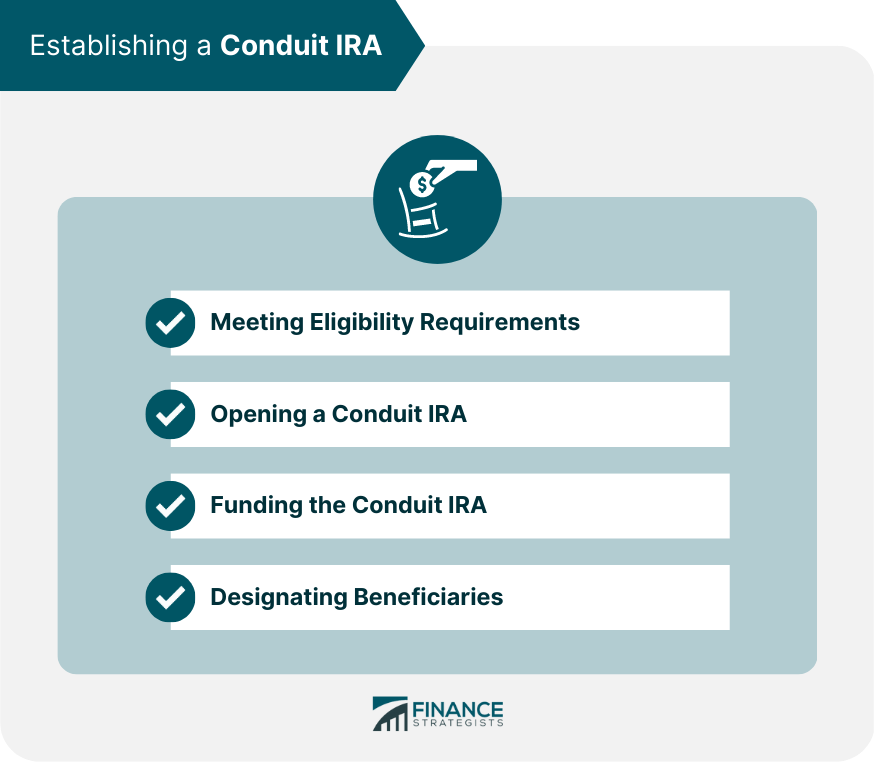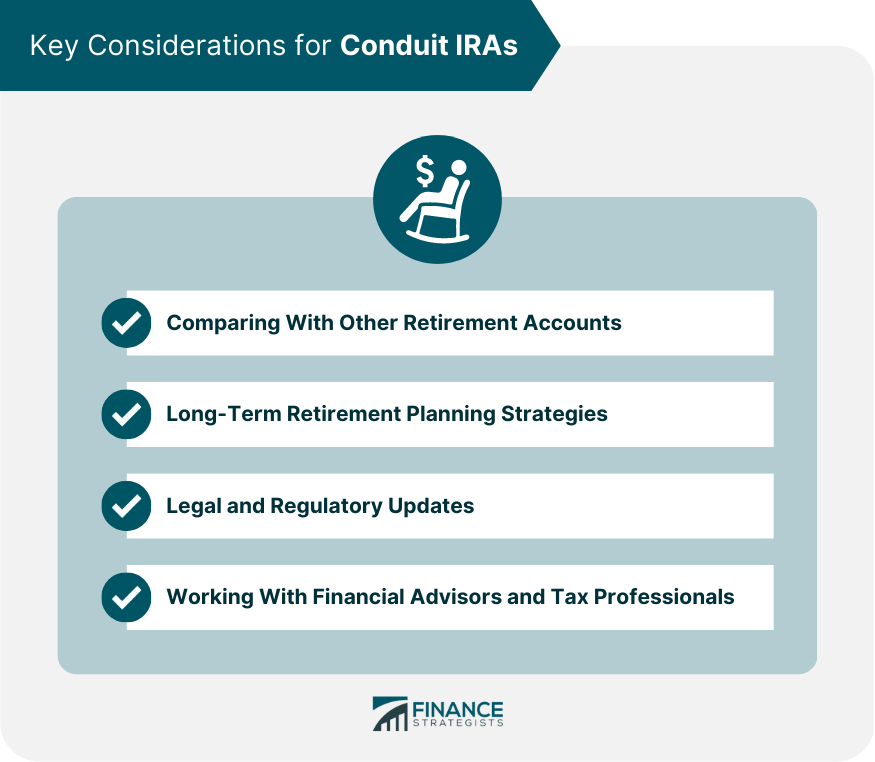A Conduit Individual Retirement Account (IRA) is a type of traditional IRA that is specifically designed to hold assets rolled over from a qualified retirement plan, such as a 401(k) or a 403(b). The primary purpose of a Conduit IRA is to temporarily hold assets in a tax-deferred account until they can be transferred to another qualified retirement plan, ensuring that the assets maintain their tax-deferred status. Conduit IRAs play a crucial role in retirement planning by offering a flexible way for individuals to manage their retirement assets. They enable individuals to consolidate multiple retirement accounts, change jobs without losing retirement savings, and access a wider range of investment options. The main advantage of a Conduit IRA is its ability to preserve the tax-deferred status of assets during a rollover. However, a key disadvantage is that any additional contributions or commingling of non-rollover assets can make the entire account ineligible for future rollovers. To establish a Conduit IRA, an individual must meet the eligibility requirements for a traditional IRA, which include having earned income and being under 70½ years of age. Opening a Conduit IRA account involves selecting a financial institution, such as a bank or brokerage firm, and completing the required account opening forms. It is essential to specify that the account is a Conduit IRA to ensure proper handling of rollover assets. A Conduit IRA can be funded through a rollover or transfer from an eligible retirement plan. Individuals should work closely with their plan administrators to initiate the process and ensure a smooth transfer of assets. When establishing a Conduit IRA, it is important to designate beneficiaries who will inherit the account's assets upon the account holder's death. This can be done during the account opening process or updated at a later time. A Conduit IRA can accept rollovers from various types of qualified retirement plans, including: Traditional IRA Other qualified plans, such as defined benefit or profit-sharing plans There are two methods for rolling over assets into a Conduit IRA: direct and indirect rollovers. In a direct rollover, the plan administrator transfers the assets directly to the Conduit IRA. In an indirect rollover, the individual receives the assets and must deposit them into the Conduit IRA within 60 days to avoid tax penalties. There are no specific timing or frequency restrictions for rolling over assets into a Conduit IRA. However, individuals should be aware of the one-rollover-per-year rule for IRAs when conducting indirect rollovers. When rolling over assets into a Conduit IRA, it is crucial to follow the applicable rules and regulations to maintain the tax-deferred status of the assets. This includes avoiding the commingling of non-rollover assets and ensuring that the receiving account is designated as a Conduit IRA. Rollovers and transfers to a Conduit IRA are generally not subject to taxes if executed correctly. However, any taxes withheld from an indirect rollover must be replaced within the 60-day period to avoid tax penalties. Proper reporting of rollovers on tax forms is necessary to ensure compliance with tax laws. Conduit IRAs offer a wide range of investment options, including stocks, bonds, mutual funds, and exchange-traded funds (ETFs). This allows account holders to tailor their investment strategy according to their risk tolerance, time horizon, and financial goals. Proper asset allocation and diversification are crucial for managing a Conduit IRA effectively. Account holders should regularly review and adjust their investment mix to ensure it remains aligned with their retirement objectives and risk tolerance. Regularly monitoring the performance of a Conduit IRA is essential for making informed decisions about asset allocation and investment strategies. Account holders should track their account's progress against their retirement goals and make adjustments as needed. As retirement approaches or financial goals change, account holders may need to adjust their investment strategy within their Conduit IRA. This may involve shifting assets to more conservative investments or rebalancing the portfolio to maintain the desired level of diversification. Conduit IRAs are subject to Required Minimum Distributions (RMDs) once the account holder reaches age 73. RMDs are calculated based on the account balance and life expectancy, and they must be taken annually to avoid penalties. Withdrawals from a Conduit IRA before the age of 59½ are generally subject to a 10% early withdrawal penalty, in addition to any applicable income taxes. However, there are exceptions for certain qualified expenses and situations. Certain withdrawals from a Conduit IRA may be exempt from the early withdrawal penalty, including those for qualified higher education expenses, first-time home purchases, and specific medical expenses. It is important to review the IRS guidelines for qualified withdrawals to avoid penalties. Withdrawals from a Conduit IRA are generally taxed as ordinary income. Account holders should consider the tax implications of withdrawals and consult with a tax professional when planning distributions. Account holders may choose to convert their Conduit IRA to a Roth IRA to take advantage of tax-free withdrawals in retirement. There are no income limits or restrictions on eligibility for conversions. Converting a Conduit IRA to a Roth IRA involves transferring the assets from the Conduit IRA to a new or existing Roth IRA account. This process can be executed through a direct rollover or a 60-day indirect rollover. Converting a Conduit IRA to a Roth IRA is a taxable event. The amount converted is generally subject to income taxes in the year of the conversion. Proper reporting of the conversion on tax forms is required to ensure compliance with tax laws. Account holders may choose to close their Conduit IRA for various reasons, such as rolling the assets into another qualified retirement plan, converting to a Roth IRA, or liquidating the account for personal use. When closing a Conduit IRA, account holders can transfer the assets to another qualified retirement plan, convert them to a Roth IRA, or withdraw the funds as a taxable distribution. Closing a Conduit IRA may have tax implications, depending on the chosen method for handling the assets. Account holders should consult with a tax professional to understand the potential tax consequences and reporting requirements. Conduit IRAs should be compared with other retirement account options, such as traditional IRAs, Roth IRAs, and employer-sponsored plans, to determine the most appropriate retirement savings strategy for an individual's financial situation and goals. Conduit IRAs are just one component of a comprehensive retirement planning strategy. Individuals should consider their long-term financial goals, risk tolerance, and investment options when designing a retirement plan that meets their needs. Staying informed about changes to tax laws, regulations, and contribution limits is essential for effectively managing a Conduit IRA. Account holders should periodically review their retirement planning strategies in light of any changes to ensure continued compliance and optimal financial outcomes. Consulting with financial advisors and tax professionals can be invaluable in navigating the complexities of Conduit IRAs and other retirement planning options. These professionals can offer personalized guidance and recommendations based on an individual's unique financial situation and goals. Conduit IRAs serve as an essential tool for retirement planning, offering flexibility and tax advantages when managing retirement assets. They provide a valuable option for individuals who change jobs frequently or have multiple retirement accounts from different employers. When considering a Conduit IRA, individuals should weigh the advantages and disadvantages, assess their eligibility, and review the tax implications associated with rollovers and withdrawals. Working with financial advisors and tax professionals can help ensure that a Conduit IRA is effectively integrated into an individual's overall retirement planning strategy.What Is a Conduit IRA?
Establishing a Conduit IRA
Meeting Eligibility Requirements
Opening a Conduit IRA Account
Funding the Conduit IRA
Designating Beneficiaries

Rollovers and Transfers
Types of Eligible Retirement Plans
Direct and Indirect Rollovers
Timing and Frequency Restrictions
Rollover and Transfer Rules
Tax Implications and Reporting
Managing a Conduit IRA
Investment Options
Asset Allocation and Diversification
Monitoring Account Performance
Adjusting Investments
Distribution and Withdrawals
Required Minimum Distributions (RMDs)
Early Withdrawal Penalties
Qualified Withdrawals and Exceptions
Tax Implications of Withdrawals
Conduit IRA to Roth IRA Conversion
Eligibility and Benefits
Conversion Process
Tax Implications and Reporting
Closing a Conduit IRA
Reasons for Closing a Conduit IRA
Options for Handling Assets
Tax Implications and Reporting
Key Considerations for Conduit IRAs
Comparing With Other Retirement Accounts
Long-Term Retirement Planning Strategies
Legal and Regulatory Updates
Working With Financial Advisors and Tax Professionals

Conclusion
Conduit IRA FAQs
A Conduit IRA is a type of Individual Retirement Account that allows investors to invest in alternative assets such as real estate, private equity, and hedge funds through a self-directed IRA.
With a Conduit IRA, an investor establishes a self-directed IRA and then sets up a separate LLC to hold the alternative investments. The IRA then invests in the LLC, which is considered a "conduit" for the investment funds. The LLC manages the assets, and any gains or losses flow back to the IRA.
One of the primary benefits of a Conduit IRA is the ability to invest in alternative assets that may offer higher potential returns than traditional investments like stocks and bonds. Additionally, because the LLC acts as a conduit, the investor has more control over the management of the assets.
The biggest risk of a Conduit IRA is that the investments are not protected by the Employee Retirement Income Security Act (ERISA), which means that the investor assumes all of the risk associated with the investments. Additionally, managing an LLC can be complex, and investors may need to hire a professional to help with compliance and tax issues.
A Conduit IRA is best suited for experienced investors who are comfortable taking on additional risk and who have a good understanding of the alternative assets they are investing in. Additionally, investors should have the time and resources to manage an LLC and handle the tax and compliance issues associated with it.
True Tamplin is a published author, public speaker, CEO of UpDigital, and founder of Finance Strategists.
True is a Certified Educator in Personal Finance (CEPF®), author of The Handy Financial Ratios Guide, a member of the Society for Advancing Business Editing and Writing, contributes to his financial education site, Finance Strategists, and has spoken to various financial communities such as the CFA Institute, as well as university students like his Alma mater, Biola University, where he received a bachelor of science in business and data analytics.
To learn more about True, visit his personal website or view his author profiles on Amazon, Nasdaq and Forbes.















